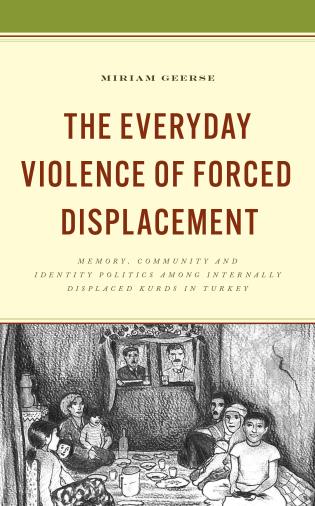The Everyday Violence of Forced Displacement: Memory, Community and Identity Politics among Internally Displaced Kurds in Turkey is based on ethnographic research in four Istanbul neighborhoods in the early 2000s and after. Miriam Geerse focuses on individuals and families that tried to sustain meaningful lives in an urban context marked by political and structural violence. Geerse argues that forces, other than war and forced displacement, instilled in many forced migrants a pressing need and desire to keep hammering home the price and pain of displacement. Much of this book then bears witness to the formation of an oppositionalconsciousness. Geerse’s analysis of the mobilization of social capital in times of illness and social conflict offers an understanding of how a dispersed community of people who share the same stories function in an inhospitable urban environment. In laying bare the interconnections between experiences before, during and after forced displacement, and by focusing on people’s narratives and their experiences, Geerse provides insight to activists striving to improve the position of Kurds, to academics studying the impact of forced migration and other forms of political violence on civilians, and to all those who argue for a more balanced view of the recent history of Turkey.
Commentary by Martin van Bruinessen
Miriam Geerse’s book offers fascinating and complex insights in how Kurdish migrants to Istanbul, many of whom had been forced to leave their villages or towns in Eastern Turkey, were refashioning their lives and shaping new community relations in the inhospitable and often hostile new surroundings of Turkey’s largest city in the early 2000s. It also shows in subtle ways how the state’s counterinsurgency measures, society’s prejudice against the Kurds, and the resurgent Kurdish movement impacted on individual lives.
The1990s had been a period of promise and hope but also intense suffering for the Kurds. After a period of military rule in which all political parties and civic associations were banned, a gradual liberalization allowed a freer and more diverse press and electronic media landscape and the beginnings of civil society to emerge. In politics, the first “pro-Kurdish” political party (HEP) emerged as Kurdish members of parliament who had attended a Kurdish conference in Paris were expelled from their party (The Social-Democrat Populist Party, SHP) and formed a new group under the banner of the HEP (People’s Labor Party). This party was soon banned but replaced by another “pro-Kurdish” party, DEP, and this in turn by HADEP, DEHAP, and a series of later parties. For the first time, Kurdish voices were heard in Turkey’s parliament and, especially through HADEP, as elected officials in local administrations. The decade had moreover begun with the lifting of a ban on publishing in Kurdish (and other minority languages), allowing the rapid flourishing of a Kurdish press, with journals, numerous books on Kurdish language, history and society, and a “pro-Kurdish” newspaper.
At the same time, however, this was a period of unprecedented repression, as the “dirty war” against the PKK culminated in the mid-1990s. Tansu Çiller, who replaced Süleyman Demirel as Prime Minister in 1993, initially spoke of the “Basque solution” as an example to be emulated by Turkey – referring to Spain’s peaceful ending of the violent conflict with separatist Basque nationalists. Soon, however, she was persuaded by the military to support a violent escalation in the war against the PKK, in which thousands of villages were destroyed and their inhabitants forced to leave the area. At the same time, the intelligence services began a campaign of targeted assassinations of politicians, lawyers, businessmen and civil society activists suspected of PKK connections, to which thousands fell victim. The “dirty war” resulted in the uprooting of hundreds of thousands, possibly even millions, from the rural parts of Eastern and Southeastern Turkey. Most of these initially settled in towns and cities of the region and later moved on to metropoles such as Mersin, Izmir, Ankara and Istanbul, in search of work and other opportunities.
Human rights organizations and concerned academics have written reports and scholarly articles on these massive waves of forced migrations, from which one could easily get the impression that there was a simple and straightforward connection between military operations in the mountains of Eastern Turkey and the arrival of large numbers of forced migrants in Istanbul. I have myself written some reports that in retrospect, I believe, were too generalizing and that gave a simplified representation of complex processes, focussing on numbers of destroyed villages and estimates of the volume of population movements, without much attention to the experience and motivation of the individual migrant. Miriam Geerse’s empirically rich and sophisticated anthropological account of the everyday lives and personal histories of migrants, before and after their arrival in Istanbul, makes their experiences tangible and constitutes a valuable complement and corrective to dry statistics and abstract analyses of social transformation.
When Miriam began her field research, around the turn of the millennium, many of the people uprooted by the armed conflict between the Turkish armed forces and the PKK had meanwhile reached Istanbul, after shorter or longer stays at intermediate places. She decided to focus on several neighborhoods in the Asian side of Istanbul where many recent migrants had settled and she lived, with her family, for some five years in a nearby neighborhood. This allowed her to visit these immigrant communities regularly, establish relations of trust with migrant families, and observe their daily social life, the struggle for economic survival, forms of co-operation and conflict, and relations of authority within the emerging communities at close range.
From the narratives of her interviewees about life in the village before departure, their reasons for leaving the village, the stages of their migration journey before they ended up in Istanbul, and the social connections that played a role in their decision to settle in that particular district of Istanbul, it became clear that the actual torching of villages and forced expulsion of the inhabitants by the army was only the most extreme form of forced migration. The armed conflict had made life in the village hazardous and precarious well before the military operations culminated in the massive forced evacuations of the mid-1990s. Economic hardship, born of the inaccessibility of mountain pastures and fields and of limitations imposed on village trade, forced many to seek ways to survive elsewhere. There had been other forms of coercion as well: conflicts with neighboring villages or tribes (exacerbated when some of those neighbors became “village guards” and, armed by the state, could exercise private violence with impunity), but also conflicts between or even within families in the same village.
The state and the PKK figured prominently in the narratives of most of the migrant families. Miriam’s analysis of these narratives helps us to understand something that many observers of the Kurdish movement considered a mystery: the lasting popularity of the PKK among otherwise not very politicized “ordinary” Kurds, in spite of its violent reputation and the embarrassing attitude of Öcalan after he was handed over to the Turkish authorities in 1999. In not studying the history of the PKK’s political and armed struggle and its changing ideology, as others have done, but focusing on people’s narratives about the PKK in connection with their personal life histories, she makes a significant contribution to our understanding of this movement.
Miriam’s observations and interviews also show that the legal “pro-Kurdish” party (HADEP, later DEHAP) played a more important role in the community than was reflected in the outcome of elections. Among Turkish authorities and policy makers, there was the general perception that migration to Western Turkey weakened people’s sympathies for the Kurdish movement. In the Kurdish provinces, the “pro-Kurdish” party tended to perform extremely well in elections, but in the cities in Western Turkey they performed poorly; Kurdish migrants appeared to vote mainly for establishment parties. This seemed to confirm the assimilation theory first formulated by Ziya Gökalp that had inspired Turkish policies since the 1920s: the resettlement of Kurds among a Turkish majority, far from the mountains, would end up making them civilized and Turkish. There was, however, another reason for the migrants’ voting behavior, well known to urban sociologists. Migrants needed to legalize their residence status and needed infrastructure such as roads and access to water and electricity. Establishment parties promised to provide those in exchange for the migrants’ vote. The HADEP and DEHAP could not provide such services and were therefore not voted into local government or councils in Istanbul, but they proved their importance to the community in other ways. Miriam describes and analyses extensively two cases in which the local DEHAP representative successfully mediated in conflicts; she observes that the party enjoyed more legitimacy among the migrant communities than the state and its institutions. Not only people who were sympathetic to the Kurdish movement recognized its authority but also other residents of these districts. She does not make the mistake of overstating the party’s influence and concern with the communities’ problems, noting that there were several cases where it was unable or unwilling to intervene.
This is an important study that sheds light on crucial but often neglected aspects of Turkey’s Kurdish question. It makes significant contributions to the study of forced migrations, diaspora studies and nationalism studies besides the anthropology of Kurdish society and the Kurdish movement. The fieldwork on which it is based took place almost two decades ago, but Miriam’s observations remain relevant and pertinent in spite of great changes in Turkey’s political system. It is good to see Miriam Geerse’s book at last in print. It deserves a wide readership.





